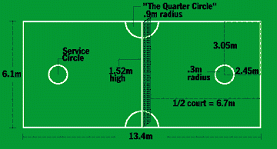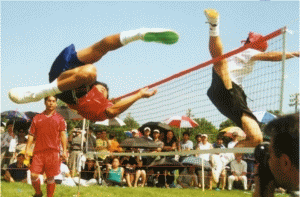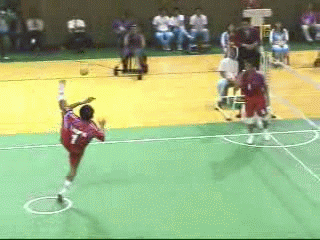
THE COURT
The court is an area of 13.4 m X 6.1 m, or 44 ft X 20 ft, free from all obstacles up to the height of 8 m, or 26.25 ft, measured from the floor surface, and free of all obstacles on the floor or ground up to a distance of at least 3.0 m, or about 10 feet, from the edges of the court all the way around.
Sidelines & Baselines – The width of the sidelines (two sides) and baselines (two back ends) bounding the court should not be more than 0.04 m, or 1 1/2 inches, measured and drawn inward from the outer edge of the court measurements.
The Centre Line – A Centre Line of 0.02m, or 3/4 inch, should be drawn across the centre of the court, from side to side, to divide the court into two equal halves.
The Quarter Circle – At the front corner of each half of the court, at the centre line, a Quarter Circle shall be drawn from the sideline to the centre line with a radius of 0.9 m, or 3 ft, measured and drawn outward from the outer edge of the radius.
The Service Circle – A Service Circle of 0.3 m, or 1 ft, radius shall be drawn on each half of the court, the centre of which is 2.45 m, or 8 ft, in from the baseline of the court and 3.05 m, or 10 ft, in from the sidelines. The 0.04 m, or 1 1/2-inch, line shall be measured and drawn outward from the outer edge of the radius
.
THE POSTS
The posts shall be 1.55 m, or 5 ft 1 inch (1.45 m, or 4 ft 9 inches, for women) in height from the floor and shall be sufficiently firm to maintain high net tension. They should be made from strong materials and shall not be more 0.04 m, or 1 1/2; inches, in radius. The posts shall be erected or placed firmly 0.3 m, or 1 ft, outside the sideline boundary and directly in line with the centre line.
THE NET
The net shall be made of fine ordinary cord or nylon with 0.06 m to 0.08 m, or 2 1/2; to 3-inch, mesh. The net shall be 0.7m, or 2 ft 4 inches, in height (top to bottom) and not shorter than 6.10 m, or 20 ft, in width (side to side). The net shall be edged on both sides along the sideline edges from top to bottom with 0.05 m, or 2-inch, tape, and shall be called Boundary Tape.
The net shall also be edged with at least 0.05 m, or 2-inch, tape on both sides along the top and bottom, and shall be supported by a fine ordinary cord or nylon cord that runs through the tape and is tightened at the posts. The top of the net shall be 1.52 m, or 5 ft, (1.42 m, or 4 ft 8 inches, for women) in height from the floor at centre court and 1.55 m, or 5 ft 1 inch (1.45 m, or 4 ft 9 inches, for women) at the posts.
THE BALL
The Sepak Takraw ball shall be spherical, made up of one woven layer of synthetic fibre, having 12 holes and 20 intersections. If it is made of rattan, it shall consist of 9 – 11 strands. For the men's event, the ball circumference shall not be less than 42 cm, or 1 ft. 4 1/2; in., and not more than 44 cm, or 1 ft. 5 5/16 in., (43 cm, or 1 ft. 4 15/16 in., to 45 cm, or 1 ft. 5 3/4; in., for the women's event). The weight before play shall not be less than 170 g, or 6 oz., and not more than 180 g, or 6.35 oz., for the men's event (150 g, or 5.3 oz., to 160 g, or 5.6 oz., for the women's event).

THE PLAYERS
A match is played by two "Regu's", each consisting of three players.
One of the three players shall be near the back of the court and he/she is called a "Tekong" (Server).
The other two players shall be in front, closer to the net, one on the left and the other on the right. The player on the left is called a "Left Forward" and the player on the right is called a "Right Forward".

PLAYER'S ATTIRE
Male players must wear shorts, jerseys/T-shirts and sports shoes with rubber souls (shorts length at least down to knee level and round neck T-shirts with sleeves, for woman players). It is forbidden for players to wear anything that endangers the opponents during the game. In case of cold weather, players are permitted to wear tracksuits.
The entire apparel of a player is regarded as part of his/her body. All jerseys/T-shirts should be tucked in.
Anything that helps to speed the ball or causes the unnatural movement of a player is not allowed.
The Captain of each regu shall wear an armband on the left arm.
All jerseys/T-shirts are to be numbered at the back. A player must be assigned with one permanent number throughout a tournament. Each participating Regu or Team is allowed to use only numbers 1 to 15. The size of the number shall not be less than 19 cm, or 7 1/2; inches, in height.
SUBSTITUTION
There shall be no repeat of the same player in any team competition involving more than one regu.
Substitution of a player is allowed at any time on request made by the Team Manager to the Official Referee when the ball is not in play.
Each regu may nominate none to maximum of two reserve players, but can make only one substitution in a match.
A player who has been sent off by the Umpire during a match may be substituted, provided no substitution has been made already.
Any regu having less than 3 players will not be allowed to continue the game and will be considered as having lost.
OFFICIALS
The game shall be managed by the following officials:
1 Official Referee
2 Umpires
6 Linespersons (4 sidelines and 2 baselines)
THE COIN TOSS AND WARM-UP
Before commencing the game, the Umpire will toss a coin or disc and the side winning the toss shall have the option of "Choosing Service" or "Choosing Side". The regu that chooses the "Service" shall "warm-up" first for 2 minutes followed by the other regu. Only 5 persons are allowed to move freely on the court with the official ball.
POSITION OF PLAYERS DURING SERVICE
At the start of play, the players of both regu's must be in their respective courts in a ready position.
The Tekong shall be standing with one of his/her feet inside the serving circle. Both of the Forward players of the serving side must be standing in their respective quarter circles.
The opponent or receiving regu is free to be anywhere within its court.
THE START OF PLAY AND SERVICE
The regu that serves first (according to the toss) shall start the first set. The side that wins the first set shall have the option of "Choosing Service" or "Choosing Side" for the second set.
The throw must be executed as soon as the umpire calls the score. If either of the Forward players throws the ball before the Umpire calls the score, it must be re-thrown and a warning will be given to the "Tosser".
During the service, as soon as the Tekong kicks the ball, all the players are allowed to move about freely in their respective courts.
The service is valid if the ball passes over the net, whether it touches the net or not, and inside the boundary of the two net tapes and boundary lines of the opponent's court – as long as even the shadow of the ball (very outer edge) is directly over the boundary line or tape, it is considered in bounds.

FAULTS
The Serving Side During Service
The Forward player who is making service throws, plays about with the ball (throwing the ball up, bumping it, giving it to other Forward player, etc.) after the call of score has been made by the Umpire.
The Forward player lifts his/her feet or steps on the line or crosses over or touches the net while tossing the ball to the Tekong during the serve.
The Tekong jumps off the ground to execute the service.
The Tekong does not KICK the ball on the service throw.
The ball touches the Tekong's own player before crossing over to the opponent's court.
The ball goes over the net but falls outside the court.
The ball does not cross to the opponent's side.
Receiving Side During Service
Creating distracting mannerisms or noise or shouting at their opponents.
For Both Sides During The Game
Any player who touches the ball on the opponent's side.
Any part of player's body crosses over into opponent's court, whether above or under the net, except during the follow-through after striking the ball from one's own side.
Playing the ball more than 3 times in succession.
The ball touches the arm or hand (except for during the service toss).
Stopping or stalling the ball on any part of the body.
Any part of a player's body or a player's outfit, e.g. shoes, jersey, head band etc., touches the net, post, umpire's chair, or any object outside the court, or falls onto the opponent's side.
The ball touches the floor, wall, ceiling or any objects during play.
Any player who intentionally delays the game unnecessarily.
SCORING SYSTEM
When either serving side or receiving side commits a fault, a point and the next service is awarded to the opposing side.
The winning point for a set is 21 points, unless the points are tied at 20-20, then the set shall be decided on a difference of two points, up to a ceiling of 25 points. When the score is tied at 20-20, the Umpire announces "Setting up to 25 points".
The match is played in 2 sets with a 2-minute rest in between.
If each regu wins one set, the match shall be decided in the third set called a "Tiebreak" with the winning points being 15 points, unless the points are tied at 14-14, then the set shall be decided on a difference of two points, up to a ceiling of 17 points. When the score is tied at 14-14, the Umpire announces "Setting up to 17 points".
Before a tiebreak set takes place, the Umpire shall toss a disc or coin, and the regu winning the toss shall have the option of "Choosing Service". The change of sides takes place when one regu reaches 8 points.
TIME-OUT
The Team Manager or Official Coach of each regu can request one time-out of one-minute rest per set when the ball is not in play. During the time-out, players go outside the court, behind the baseline. Only 5 persons are allowed behind the base line during a time-out.
TEMPORARY SUSPENSION OF PLAY
The Umpire can suspend play temporarily in the event of obstructions, disturbances or any injury to a player who needs immediate treatment, for not more than 5 minutes.
An injured player is allowed up to 5 minutes injury time-out. If after 5 minutes, the player is unable to continue, a substitution must be made. If the injured player's regu has already made a substitution, the match will be declared a forfeit in favour of the opposing regu.
In the course of such suspension, all players are not allowed to leave the court to receive drinks or any other form of assistance.
DISCIPLINE
Every player must abide by the rules of the game.
Only the Captain of a regu is allowed to approach the umpire during a match, when the ball is not in play.
PENALTY
Caution able Offences – A player is cautioned and shown the Yellow Card if he/she commits any of the following six offences:
is guilty of unsporting behaviour;
shows dissent by word or action;
persistently infringes the Laws of the Game;
delays the restart of play;
enters or re-enters the court without the referee's permission (except during regular play);
deliberately leaves the court without the referee's permission (except during regular play).
Sending-off Offences – A player is shown the red card and sent off if he/she commits any of the following five offences:
is guilty of serious foul play;
is guilty of violent conduct, including an act executed with deliberate intent to cause injury to his/her opponent;
spits at an opponent or any other person;
using offensive or insulting or abusive language and/or gestures;
receives a second caution (Yellow Card) in the same match.
Any player who commits a Caution able or Sending-Off Offence, either on or off the court, whether directed towards an opponent, team-mate, Umpire, Assistant Umpire, Official Referee or any other person, will be disciplined according to the nature of the offence committed.
MISCONDUCT OF TEAM OFFICIALS
Disciplinary action will be taken against Team Officials or his/her regu/team for any misconduct or disturbances committed by the official or regu/team during a tournament whether in or outside the court.
GENERAL
In the event of any question or any matter arising out of any point, which is not expressly provided for in any of the rules of the game, the decision of the Official Referee shall be final.